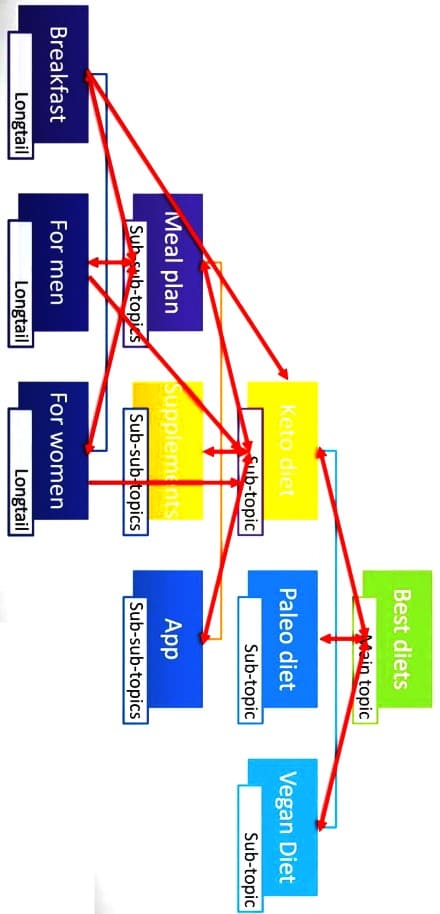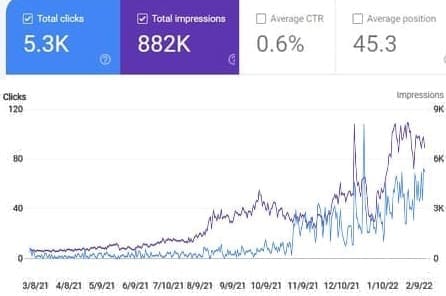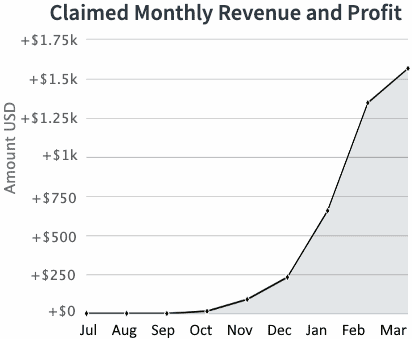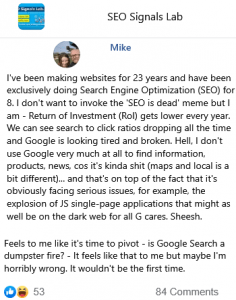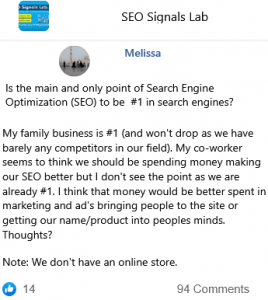Search Engine Optimization (SEO) is easy. The EXACT process we use to scale our clients' SEO from 0 to 200k monthly traffic and beyond
Hey guys!
There's a TON of content out there on SEO – guides, articles, courses, videos, scams, people yelling about it on online forums, etc etc..
Most of it, however, is super impractical. If you want to start doing SEO TODAY and start getting results ASAP, you'll need to do a TON of digging to figure out what's important and what's not.
So we wanted to make everyone's lives super easy and distill our EXACT process of working w/ clients into a stupid-simple, step-by-step practical guide. And so we did. Here we are.
A bit of backstory:
If you guys haven't seen any of my previous posts, me and my co-founder own an SEO/digital marketing agency, and we've worked w/ a ton of clients helping them go from 0 to 200k+ monthly organic traffic. We've also helped some quite big companies grow their organic traffic (from 1M to over 1.8M monthly organic), using the exact same process.
So without further ado, grab your popcorn, and be prepared to stick to the screen for a while, cause this is going to be a long post. Here's everything I am going to cover:
• Get your website to run and load 2x – 5x faster (with MINIMAL technical know-how)
• Optimize your landing pages to rank for direct intent keywords (and drive 100% qualified leads)
• Create amazing, long-form content that ranks every time
• How we get a TON of links to our website with ZERO link-building efforts
• How to improve your content's rankings with Surfer SEO
Step #1 – Technical Optimization and On-Page SEO
Step #1 to any SEO initiative is getting your technical SEO right.
Now, some of this is going to be a bit technical, so you might just forward this part to your tech team and just skip ahead to "Step #2 – Keyword Research."
If you DON'T have a tech team and want a super easy tl;dr, do this:
• Use WP Rocket. It's a WordPress plugin that optimizes a bunch of stuff on your website, making it run significantly faster.
• Use SMUSH to (losslessly) compress all the images on your website. this usually helps a TON w/ load speed.
If you're a bit more tech-savvy, though, read on!
Technical SEO Basics
Sitemap.xml file. A good sitemap shows Google how to easily navigate your website (and how to find all your content!). If your site runs on WordPress, all you have to do is install YoastSEO or Rankmath SEO, and they'll create a sitemap for you. Otherwise, you can use an online XML Sitemap generation tool.
Proper website architecture. The crawl depth of any page should be lower than 4 (i.e: any given page should be reached with no more than 3 clicks from the homepage). To fix this, you should improve your interlinking (check Step #6 of this guide to learn more).
Serve images in next-gen format. Next-gen image formats (JPEG 2000, JPEG XR, and WebP) can be compressed a lot better than JPG or PNG images. Using WordPress? Just use Smush and it'll do ALL the work for you. Otherwise, you can manually compress all images and re-upload them.
Remove duplicate content. Google hates duplicate content and will penalize you for it. If you have any duplicate pages, just merge them (by doing a 301 redirect) or delete one or the other.
Update your 'robots.txt' file. Hide the pages you don't want Google to index (e.g: non-public, or unimportant pages). If you're a Software as a Service (SaaS), this would be most of your in-app pages.
Optimize all your pages by best practice. There's a bunch of general best practices that Google wants you to follow for your web pages (maintain keyword density, have an adequate # of outbound links, etc.). Install YoastSEO or RankMath and use them to optimize all of your web pages.
If you DON'T have any pages that you don't want to be displayed on Google, you DON'T need robots.txt.
Advanced Technical SEO
Now, this is where this gets a bit more web-devvy. Other than just optimizing your website for Search Engine Optimization (SEO), you should also focus on optimizing your website speed.
Here's how to do that:
Both for Mobile and PC, your website should load in under 2-3 seconds. While load speed isn't a DIRECT ranking factor, it does have a very serious impact on your rankings.
After all, if your website doesn't load for 5 seconds, a bunch of your visitors might drop off.
So, to measure your website speed performance, you can use Pagespeed Insights. Some of the most common issues we have seen clients facing when it comes to website speed and loading time, are the following:
• Images being resized with Cascading Style Sheets (CSS) or JS. This adds extra loading time to your site. Use GTMetrix to find which images need resizing. Use an online tool (there are a ton of free ones) to properly resize images (or Photoshop even), and re-upload them.
• Images not being lazy-loaded. If your pages contain a lot of images, you MUST activate lazy-loading. This allows images that are below the screen, to be loaded only once the visitor scrolls down enough to see the image.
• Gzip compression not enabled. Gzip is a compression method that allows network file transfers to happen a ton faster. In other words, your files like your HTML, CSS, and JS load a ton faster.
• JS, CSS, and HTML not minified/aggregated/in-lined. If your website is loading slowly because you have 100+ external javascript files and stylesheets being requested from the server, then you need to look into minifying, aggregating, and inlining some of those files.
• Use Cloudflare + BunnyCDN Why the combo? Why not just Cloudflare? Well, I won't get into details, I've experimented a bit with it, and if you are looking for something cheap and fast this is the best combo. Cloudflare you can opt in for the free account. BunnyCDN on the other hand is on a pay-as-you-go basis, and unless you are getting over 100K+ visits a month, you'll likely never go above their minimum monthly threshold of $1.
Want to make your life easier AND fix up all these issues and more? Use WP Rocket. The tool basically does all your optimization for you (if you're using WordPress, of course).
Step #2 – Keyword Research
Once your website is 100% optimized, it's time to define your SEO strategy.
The best way to get started with this is by doing keyword research.
First off, you want to create a keyword research sheet. This is going to be your main hub for all your content operations.
You can use the sheet to:
• Prioritize content
• Keep track of the publishing process
• Get a top-down view of your web pages
And here's what it covers:
• Target search phrase. This is the keyword you're targeting.
• Priority. What's the priority of this keyword? We usually divide them by 1-2-3…
• Priority 3 – Top priority keywords. These are usually low competition, high traffic, well-converting, or all 3 at the same time.
• Priority 2 – Mid-priority keywords.
• Priority 1 – These are low priority.
• Status. What's the status of the article? We usually divide them by…
• 1 – Not written
• 2 – Writer has picked up the topic for the week
• 3 – The article is being written
• 4 – The article is in editing phase
• 5 – The article is published on the blog
• Topic cluster. The category that the blog post belongs to.
• Monthly search volume. Self-explanatory. This helps you pick a priority for the keyword.
• Cost Per Click (CPC) (low & high bid). Cost per click for the keyword. Generally, unless you're planning to run search ads, these are not mandatory. They can, however, help you figure out which of your keywords will convert better. Pro tip: the higher the CPC, the more likely it is for the keyword to convert well.
Now that you have your sheet (and understand how it works), let's talk about the "how" of keyword research.
How to do Keyword Research (Step-by-Step Guide)
There are a ton of different ways to do that (check the "further readings" at the end of this section for a detailed rundown).
Our favorite method, however, is as follows…
Start off by listing out your top 5 SEO competitors.
The key here is SEO competitors – competing companies that have a strong SEO presence in the same niche.
Not sure who's a good SEO competitor? Google the top keywords that describe your product and find your top-ranking competitors.
Run them through SEMrush (or your favorite SEO tool), and you'll see how well, exactly, they're doing with their SEO.
Once you have a list of 5 competitors, run each of them through "Organic Research" on SEMrush, and you'll get a complete list of all the keywords they rank on.
Now, go through these keywords one by one and extract all the relevant ones and add them to your sheet.
Once you go through the top SEO competitors, your keyword research should be around 80%+ done.
Now to put some finishing touches on your keyword research, run your top keywords through UberSuggest and let it do its magic. It's going to give you a bunch of keywords associated with the keywords you input.
Go through all the results it's going to give you, extract anything that's relevant, and your keyword research should be 90% done.
At this point, you can call it a day and move on to the next step. Chances are, over time, you'll uncover new keywords to add to your sheet and get you to that sweet 100%.
Step #3 – Create SEO Landing Pages
Remember how we collected a bunch of landing page keywords in step #2? Now it's time to build the right page for each of them! This step is a lot more straightforward than you'd think. First off, you create a custom landing page based around the keyword. Depending on your niche, this can be done in 2 ways:
• Create a general template landing page. Pretty much copy-paste your landing page, alter the sub-headings, paraphrase it a bit, and add relevant images to the use-case. You'd go with this option if the keywords you're targeting are very similar to your main use-case (e.g. "project management software" "project management system").
• Create a unique landing page for each use-case. You should do this if each use-case is unique. For example, if your software doubles as project management software and workflow management software. In this case, you'll need two completely new landing pages for each keyword.
Once you have a bunch of these pages ready, you should optimize them for their respective keywords.
You can do this by running the page content through an SEO tool. If you're using WordPress, you can do this through RankMath or Yoast SEO.
Both tools will give you exact instructions on how to optimize your page for the keyword.
If you're not using WordPress, you can use SurferSEO. Just copy-paste your web page content, and it's going to give you instructions on how to optimize it.
Once your new landing pages are live, you need to pick where you want to place them on your website. We usually recommend adding these pages to your website's navigation menu (header) or footer.
Finally, once you have all these new landing pages up, you might be thinking "Now what? How, and when, are these pages going to rank?"
Generally, landing pages are a tad harder to rank than content. See, with content, quality plays a huge part. Write better, longer, and more informative content than your competition, and you're going to eventually outrank them even if they have more links.
With landing pages, things aren't as cut and dry. More often than not, you can't just "create a better landing page."
What determines rankings for landing page keywords are backlinks. If your competitors have 400 links on their landing pages, while yours has 40, chances are, you're not going to outrank them.
Step #4 – Create SEO Blog Content
Now, let's talk about the other side of the coin: content keywords, and how to create content that ranks.
As we mentioned before, these keywords aren't direct-intent (the Googler isn't SPECIFICALLY looking for your product), but they can still convert pretty well. For example, if you're a digital marketing agency, you could rank on keywords like…
• Lead generation techniques
• Software as a Service (SaaS) marketing
• SEO content
After all, anyone looking to learn about lead gen techniques might also be willing to pay you to do it for them.
On top of this, blog post keywords are way easier to rank for than your landing pages – you can beat competition simply by creating significantly better content without turning it into a backlink war.In order to create good SEO content, you need to do 2 things right:
• Create a comprehensive content outline
• Get the writing part right
Here's how each of these work…
How to Create a Content Outline for Search Engine Optimization (SEO)
A content outline is a document that has all the info on what type of information the article should contain Usually, this includes:
• Which headers and subheaders you should use
• What's the optimal word count
• What information, exactly, should each section of the article cover
• If you're not using Yoast or Rankmath, you can also mention the SEO optimization requirements (keyword density, # of outbound links, etc.)
Outlines are useful if you're working with a writing team that isn't 100% familiar with Search Engine Optimization (SEO), allowing them to write content that ranks without any SEO know-how.
At the same time, even if you're the one doing the writing, an outline can help you get a top-down idea of what you should cover in the article.
So, how do you create an outline? Here's a simplified step-by-step process…
• Determine the target word count. Rule of thumb: aim for 1.5x – 2x whatever your competitor wrote. You can disregard this if your competition was super comprehensive with their content, and just go for the same length instead.
• Create a similar header structure as your competition. Indicate for the writer which headers should be h2, which ones h3.
• For each header, mention what it's about. Pro tip – you can borrow ideas from the top 5 ranking articles.
• For each header, explain what, exactly, should the writer mention (in simple words).
• Finally, do some first-hand research on Reddit and Quora. What are the questions your target audience has around your topic? What else could you add to the article that would be super valuable for your customers?
How to Write Well
There's a lot more to good content than giving an outline to a writer. Sure, they can hit all the right points, but if the writing itself is mediocre, no one's going to stick around to read your article.
Here are some essential tips you should keep in mind for writing content (or managing a team of writers):
• Write for your audience. Are you a B2B enterprise SaaS? Your blog posts should be more formal and professional. B2C, super-consumer product? Talk in a more casual, relaxed fashion. Sprinkle your content with pop culture references for bonus points!
• Avoid fluff. Every single sentence should have some sort of value (conveying information, cracking a joke, etc.). Avoid beating around the bush, and be as straightforward as possible.
• Keep your audience's knowledge in mind. For example, if your audience is a bunch of rocket scientists, you don't have to explain to them how 1+1=2.
• Create a writer guideline (or just steal ours! -> edit: sorry had to remove link due to posting guidelines)
• Use Grammarly and Hemingway. The first is like your personal pocket editor, and the latter helps make your content easier to read.
• Hire the right writers. Chances are, you're too busy to write your own content. We usually recommend using ProBlogger or Cult of Copy Job Board (Facebook Group) to source top writing talent.
Step #5 – Start Link-Building Operations
Links are essential if you want your content or web pages to rank.
If you're in a competitive niche, links are going to be the final deciding factor on what ranks and what doesn't.
In the Virtual Private Network (VPN) niche, for example, everyone has good content. That's just the baseline. The real competition is in the backlinks.
To better illustrate this example, if you Google "best VPN," you'll see that all top-ranking content pieces are almost the same thing. They're all:
• Well-written
• Long-form
• Easy to navigate
• Well-formatted (to enhance User Experience (UX))
So, the determining factor is links. If you check all the top-ranking articles with the Moz Toolbar Extension, you'll see that on average, each page has a minimum of 300 links (and some over 100,000!).
Meaning, to compete, you'll really need to double-down on your link-building effort.
In fact, in the most competitive SEO niches, it's not uncommon to spend $20,000 per month on link-building efforts alone.
Pro Tip
Got scared by the high $$$ some companies spend on link-building? Well, worry not!
Only the most ever-green niches are so competitive. Think, Virtual Private Network (VPN), make money online, health and fitness, dating, CBD, gambling, etc. So you know, the usual culprits.
For most other niches, you can even rank with minimal links, as long as you have top-tier SEO content.
Now, let's ask the million-dollar question: "how do you do link-building?"
4 Evergreen Link Building Strategies for Any Website
There are a TON of different link building strategies on the web. Broken link building, scholarship link building, stealing competitor links, and so on and so on and so on.
We're not going to list every single link building strategy out there (mainly because Backlinko already did that in their link building guide).
What we are going to do, though, is list out some of our favorite strategies, and link you to resources where you can learn more:
• Broken link building. You find dead pages with a lot of backlinks, reach out to websites that linked to them, and pitch them something like "hey, you linked to this article, but it's dead. We thought you'd want to fix that. You can use our recent article if you think it's cool enough."
• Guest posting. Probably the most popular link building strategy. Find blogs that accept guest posts, and send them a pitch! They usually let you include 1-2 do-follow links back to your website.
• "Linkable asset" link building. A linkable asset is a resource that is so AWESOME that you just can't help but link to. Think, infographics, online calculators, first-hand studies or research, stuff like that. The tl;dr here is, you create an awesome resource, and promote the hell out of it on the web.
• Skyscraper technique. The skyscraper technique is a term coined by Backlinko. The gist of it is, you find link-worthy content on the web, create something even better, and reach out to the right people.
Most of these strategies work, and you can find a ton of resources on the web if you want to learn more.
However, if you're looking for something a bit different, oh boy we have a treat for you! We're going to teach you a link-building strategy that got us around:
• 10,000+ traffic within a week
• 15+ leads
• 50+ links
…And so much more, all through a single blog post.
Link-Building Case Study: SaaS Marketing
"So, what's this ancient link-building tactic?"
I hear you asking. It must be something super secretive and esoteric, right?
Secrets learned straight from the link-building monks at an ancient SEO temple…
"Right?"
Well, not quite.
The tactic isn't something too unusual – it's pretty famous on the web. This tactic comes in 2 steps:
• Figure out where your target audience hangs out (create a list of the channels)
• Research the type of content your audience loves
• Create EPIC content based on that research (give TONS of value)
• Promote the HELL out of it in the channels from step 1
Nothing too new, right?
Well, you'd be surprised how many people don't use it.
Now, before you start throwing stones at us for overhyping something so simple, let's dive into the case study:
How we PR'd the hell out of our guide to Software as a Service (SaaS) marketing (can't add a link, but it's on our blog and it's 14k words long), and got 10k+ traffic as a result.
A few months back when we launched our blog, we were deciding on what our initial content should be about.
Since we specialize in helping SaaS companies acquire new users, we decided to create a mega-authority guide to SaaS marketing (AND try to get it to rank for its respective keyword).
We went through the top-ranking content pieces, and saw that none of them was anything too impressive.
Most of them were about general startup marketing strategies – how to validate your Minimum Viable Products (MVP), find a product-market fit, etc.
Pretty "meh," if you ask us. We believe that the #1 thing founders are looking for when Googling "SaaS marketing" are practical channels and tactics you can use to acquire new users.
So, it all started off with an idea: create a listicle of the top SaaS marketing tactics out there:
• How to create good content to drive users
• Promote your content
• Rank on Google
• Create viral infographics
• Create a micro-site
…and we ended up overdoing it, covering 41+ different tactics and case studies and hitting around 14k+ words.
On one hand, oops! On the other hand, we had some pretty epic content on our hands. We even added the Smart Content Filter to make the article much easier to navigate.
Once the article was up, we ran it through some of our clients, friends, and acquaintances, and received some really good feedback.
So, now we knew it was worth promoting the hell out of it.
We came up with a huge list of all online channels that would appreciate this article:
• r/ entrepreneur and r/ startups (hi guys!). The first ended up loving the post, netting us ~600 upboats and a platinum medal. The latter also ended up loving the post, but the mods decided to be assholes and remove it for being "self-promotional." So, despite the community loving the content, it got axed by the mods. Sad. (Fun fact – this one time we tried to submit another content piece on r/ startups with no company names, no links back to our website, or anything that can be deemed promotional. One of the mods removed it for mentioning a link to Ahrefs . Go figure!)
• Hacker News. Tons of founders hang out on HN, so we thought they'd appreciate anything SaaS-related. This netted us around ~200+ upvotes and some awesome feedback (thanks HN!)
• Submit on Growth Hackers, Indie Hackers, and all other online marketing communities. We got a bunch of love on Indie Hackers, the rest were quite inactive.
• Reach out to all personal connects + clients and ask for a share
• Run Facebook/Twitter ads. This didn't particularly work out too well for us, so we dropped it after 1-2 weeks.
• Run a Quuu promotion. If you haven't heard of Quuu, it's a platform that matches people who want their content to be shared, with people who want their social media profiles running on 100% auto-pilot. We also got "meh" results here – tons of shares, next to no likes or link clicks.
• Promoted in Software as a Service (SaaS) and marketing Facebook groups. This had awesome results both in terms of traffic, as well as making new friends, AND getting new leads.
• Promoted in entrepreneur Slack channels. This worked OK – didn't net us traffic, but got us some new friends.
• Emailed anyone we mentioned in the article and asked for a share. Since we mentioned too many high profile peeps and not enough non-celebs, this didn't work out too well
• Emailed influencers that we thought would like the article / give it a share. They didn't. We were heart-broken.
And accordingly, created a checklist + distribution sheet with all the websites or emails of people we wanted to ping.
Overall, this netted us around 12,000 page views in total, 15+ leads, 6,000 traffic in just 2 promotion days.
As for SEO results, we got a bunch of links. (I would have added screenshots to all of these results, but don't think this subreddit allows it).
A lot of these are no-follow from Reddit, HackerNews, and other submission websites, but a lot of them are also pretty authentic.
The cool part about this link-building tactic is that people link to you without even asking. You create awesome content that helps people, and you get rewarded with links, shares, and traffic!
And as for the cherry on top, only 2 months after publishing the article, it's ranking on position #28. We're expecting it to get to page 1 within the new few months and top 3 within the year.
Step #6 – Interlink Your Pages
One of Google's ranking factors is how long your visitors stick around on your website.
So, you need to encourage users reading ONE article, to read, well, the rest of them (or at least browse around your website). This is done through interlinking.
The idea is that each of your web pages should be linked to and from every other relevant page on your site.
Say, an article on "how to make a resume" could link to (and be linked from) "how to include contact info on a resume," "how to write a cover letter," "what's the difference between a CV and a resume," and so on.
Proper interlinking alone can have a significant impact on your website rankings. NinjaOutreach, for example, managed to improve their organic traffic by 40% through better interlinking alone.
So, how do you do interlinking "right?"
First off, make it a requirement for your writers to link to the rest of your content. Add a clause to your writer guidelines that each article should have 10+ links to your other content pieces.
More often than not, they'll manage to get 60-70% of interlinking opportunities. To get this to 100%, we usually do bi-annual interlinking runs. Here's how that works.
Pick an article you want to interlink. Let's say, for example, an article on 'business process management'.
The goal here is to find as many existing articles on your blog, where 'business process management' is mentioned so that we can add a link to the article.
Firstly, Google the keyword 'business process management' by doing a Google search on your domain. You can use the following query:
site:yourwebsite.com "keyword"
In our case, that's:
site:example.com "business process management"
You'll get a complete list of articles that mention the keyword "business process management.
Now, all you have to do is go through each of these, and make sure that the keyword is hyperlinked to the respective article!
You should also do this for all the synonyms of the keyword for this article. For example, "BPM" is an acronym for business process management, so you'd want to link this article there too.
Step #7 – Track & Improve Your Headline CTRs
Article CTRs play a huge role in determining what ranks or not.
Let's say your article ranks #4 with a Click Through Rate (CTR) of 15%. Google benchmarks this CTR with the average CTR for the position.
If the average CTR for position #4 is 12%, Google will assume that your article, with a CTR of 15% is of high quality, and will reward you with better rankings.
On the other hand, if the average CTR is 18%, Google will assume that your article isn't as valuable as other ranking content pieces, and will lower your ranking.
So, it's important to keep track of your Click Through Rates for all your articles, and when you see something that's underperforming, you can test different headlines to see if they'll improve CTR.
Now, you're probably wondering, how do you figure out what's the average CTR?
Unfortunately, each search result is different, and there's no one size fits all formula for average CTR.
Over the past few years, Google has been implementing a bunch of different types of search results – featured snippet, QAs, and a lot of other types of search results.
So, depending on how many of these clutter and the search results for your given keyword, you'll get different average CTRs by position.
Rule of thumb, you can follow these values:
• 1st position -> ~31.73% CTR
• 2nd pos. -> ~24.71%
• 3rd pos. -> 18.66%
• 4th pos. -> 13.60%
• 5th -> 9.51%
• 6th -> 6.23%
• 7th -> 4.15%
• 8th -> 3.12%
• 9th -> 2.97%
Keep in mind these change a lot depending on your industry, Pay Per Click (PPC) competitiveness, 0-click searches, etc…
Use a scraping tool like Screaming Frog to extract the following data from all your web pages:
• Page title
• Page URL
• Old Headline
Delete all the pages that aren't meant to rank on Google. Then, head over to Google Search Console and extract the following data for all the web pages:
• CTR (28 Day Range)
• Avg. Position
Add all of this data to a spreadsheet.
Now, check what your competition is doing and use that to come up with new headline ideas. Then, put them in the Title Ideas cell for the respective keyword.
For each keyword, come up with 4-5 different headlines, and implement the (seemingly) best title for each article.
Once you implement the change, insert the date on the Date Implemented column. This will help you keep track of progress.
Then, wait for around 3 – 4 weeks to see what kind of impact this change is going to have on your rankings and Click Through Rate (CTR).
If the results are not satisfactory, record the results in the respective cells, and implement another test for the following month. Make sure to update the Date Implemented column once again.
Step #8 – Keep Track of Rankings & Make Improvements On-The-Go
You're never really "done" with SEO – you should always keep track of your rankings and see if there's any room for improvement.
If you wait for an adequate time-frame after publishing a post (6 months to a year) and you're still seeing next to no results, then it might be time to investigate.
Here's what this usually looks like for us:
• Audit the content
• Is your content the adequate word count? Think, 1.5-2x your competitors.
• Is the content well-written?
• Do the images in your article add value? E.g. no stock or irrelevant images.
• Is the content optimized for Search Engine Optimization (SEO)? Think, keyword density, links to external websites, etc.
• Audit internal links
• Does the content link to an adequate number of your other articles or web pages?
• Is the article linked to from an adequate number of your web pages or blog posts? You can check this on Search Console => Links => Internal Links. Or, if you're using Yoast or RankMath, you can check the # of internal links a post has in the WordPress Dashboard -> Posts.
• Audit the backlinks
• Do you have as many backlinks as your competitors?
• Are your backlinks from the countries you want to rank in? If you have a bunch of links from India, but you want to rank in the US, you'd need to get more US links.
• Are your links high quality? More often than not, low Domain Authority (DA) / Page Authority (PA) links are not that helpful.
• Did you disown low-quality or spam links?
• Audit web page
• Does the web page load too slow? Think, 4+ seconds.
• Did you enable lazy loading for the images?
• Did you compress all images on the web page?
…And that's it.
Hope you guys had a good read and learned a thing or two :) HMU if you have any questions.
Can't add a link to the blog post (for better readability) due to posting guidelines, sorry.
202 💬🗨
📰👈
You can rank pages without backlinks
It has been proven time and time again
I agree, in most cases, you can. But there are some super competitive niches where competitors have millions of backlinks, and it's almost impossible to compete with them without continuous link building.
millions of backlinks, and it's almost impossible to compete with them without continuous link building.
I had 2 backlinks and I ranked higher compared a billion dollar company for their products.
People are giving too much value in backlinks
SamNelsonAM
Of course it's possible.
But, links are a pretty important ranking factor and you're trying to get the best overall package.
Try rank for the VPN keywords OP mentioned without links or anything semi-competitive without any links to the domain or page, pretty much impossible.
Also I see you are referring to "DA" which is just a 3rd party Moz metric. Also "more links" doesn't mean too much either. The best metric is traffic, even for a backlink.
Another thing is you don't get a Moz DA 30 from not having any links, even then you would have dozens or hundreds of links depending on the quality of them (pointing to the domain.)
So, they built up strength to their domain… with links.
The point is if everyone on a SERP has links and if you don't, you're not going to rank in front of them.
Nobody is saying links are the only ranking factor, but they are a ranking factor.
The main thing is you're beating your competition overall in the ranking factors, whether you use links is up to you.
But, if you aren't and your competition is, you're at a massive disadvantage.
Edit: Just took a look at the best Facebook groups for entrepreneurs keyword, of course he is going to rank in front of sites that write 10 groups and he wrote 54+. Plus, he has also recently updated his page.
But, if the others would write 54+ too, have similar engagement signals and have links, they would rank above him.
Also, I like to see links as what gets you from page 2- 7 to page 1, once you're there engagement signals is what keeps you there.
jjjllee
Can this work for local businesess? I have a tree company that I'm looking to scale right now and wondering if this could be used for that.
Not all of the advice above will work for a local business.
The technical optimization part will definitely help out. Keyword research is also needed for local businesses, however, it's done in a slightly different way.
In most cases, you'll need to rank for a handful of keywords max. The formula is:
"service you offer" + in + "location" (and whatever variations you can come up with). For example:
• interior design firm in new york
• interior design agency in new york
• interior design agency new york
and then also some more generic keywords
• interior designers near me
• interior design firm near me
• etc, you get the point.
If you have different locations, you can create a separate landing page for each location to target these keywords.
Also, for local businesses, what moves the needle is:
• getting G Maps 5 star reviews
• keeping an updated Google My Biz (GMB) profile
• doing citation building with a correct/uniform Name, Address & Phone Number (NAP) (Name, Address, Phone number), for each listing
Finally, in terms of creating blog content for local businesses, I'd say it depends on the niche. For most local businesses, it's not worth it focusing on creating blog content.
flibbidygibbit
B2C, super-consumer product? Talk in a more casual, relaxed fashion. Sprinkle your content with pop culture references for bonus points!
This.
I asked my target audience if a tool I'm writing should display/accept measurements in metric or imperial units. The Facebook poll options I provided were "Quarter Pounder" or "Royale with Cheese".
A couple hundred people responded within an hour, and there were at least thousand "reactions" (mostly laughing and hearts) and at least 100 people talking about Pulp Fiction (and Tarantino in general). This was in a private group of about 2,000 people, mostly in North America.
Nostalgia is a powerful drug.
And for the record, the result was "Quarter Pounder".
Thanks for sharing this! Makes me want to re-watch Pulp Fiction 😀
bettermentflux
Excellent guide. Thanks so much for taking the time to put it together.
The one area that I noted you didn't really touch on that's been a priority in my mind is semantic design. IE, proper use of H1, H2, H3 headings, and the like.
When we do a page audit, I'm often surprised to discover that designers often conflate the look of the page for the SEO priorities.
Note to designers: You can have something that's large and eye-catching without it being an H1 heading, and you can style page items that describe your SEO priorities without headings needing to be huge.
I'll often see things like "WELCOME" as an H1. Or a dozen generic and unhelpful instances of H2 headings that serve only to muddy the waters.
It should look like a table of contents; usually, a single H1 heading to tell Google and readers what the page priority is, followed by H2 and H3 headings defining the various page sections and sub-sections. Paragraphs, lists, and so on are sorted away within.
Again, a fantastic guide!
Thank you! Appreciate it!
We usually include that in the writer's guidelines. However, I couldn't include a link due to the posting rules.
HumbleBrothers
Did you originally used to do Search Engine Optimization (SEO) in house for a company and eventually moved on to your own company? If so, can you explain the process to how you got to where you are today? I've been thinking I want to start my own agency once I have enough knowledge and foundational skills under my belt.
Yeah, initially I used to manage SEO & Content for a workflow SaaS. From there, I moved on to freelancing. A few years later, we co-founded the agency with a friend of mine (who has a very supplementary skillset to mine).
Sorry for the tl;dr; but describing the whole process/journey would probably need 1 or 2 posts of its own.
FlowerFlourFloor
Serve images in next-gen format. Next-gen image formats (JPEG 2000, JPEG XR, and WebP) can be compressed a lot better than JPG or PNG images. Using WordPress? Just use Smush and it'll do ALL the work for you. Otherwise, you can manually compress all images and re-upload them.
My developer is saying that we cannot do this, as all browsers don't support these formats? Is this where the fallback comes into play?
You can keep using PNG and serve your images via a Content Delivery Network (CDN) + lazy-load them.
SnooPets1873
SEO – 9 out of 10 online clients utilize web crawlers to search for data. They do this by composing in a keyword or a keyword expression. Consequently, an internet searcher's perplexing arrangement of calculations filter through the tremendous measure of website pages ordered and broke down by "creepy crawlies". These robot scouts are essentially programming that slithers through the substance of these website pages, which web crawlers coordinate with keyword phrases utilized during look. That is the reason keywords are significant during the time spent coordinating your site substance to what your focused on watchers are searching for. Your determination of keyword expressions ought to be focused to the right sort of traffic that experiences your site – web traffic that changes over into paying clients. On the off chance that you utilize an inappropriate arrangements of keywords, you'll just draw in rush hour gridlock that won't add to your business main concern. That is the reason legitimate keyword research lies at the core of an effective Internet promoting effort. On the off chance that a couple of words could portray what your site substance ought to be, that would utilize the correct keyword state. Preferably, you should look for keywords that countless individuals are utilizing during on the web look and simultaneously utilized by a moderately low number of contenders. That would be conceivable in the event that you bring the accompanying fundamentals into legitimate thought.
📰👈
AMA Case Study: Amazon Affiliate Website From $267 to $21,853 per Month in 19 Months
A GMB Map Ranking Strategy that Works!
Tips to Improve Organic CTRs (Click Through Rates)
A 6-Month BackLink Building Case Study Including
How Insanely Valuable YouTube is for Website Rankings!
An SEO Case Study Improved 30 Percents of Prev Traffic in 3 Months on an eCommerce Website
Strategy to offset the new Google Update that works Positively
An SEO Case Study on My Reverse Content Post Clustering


